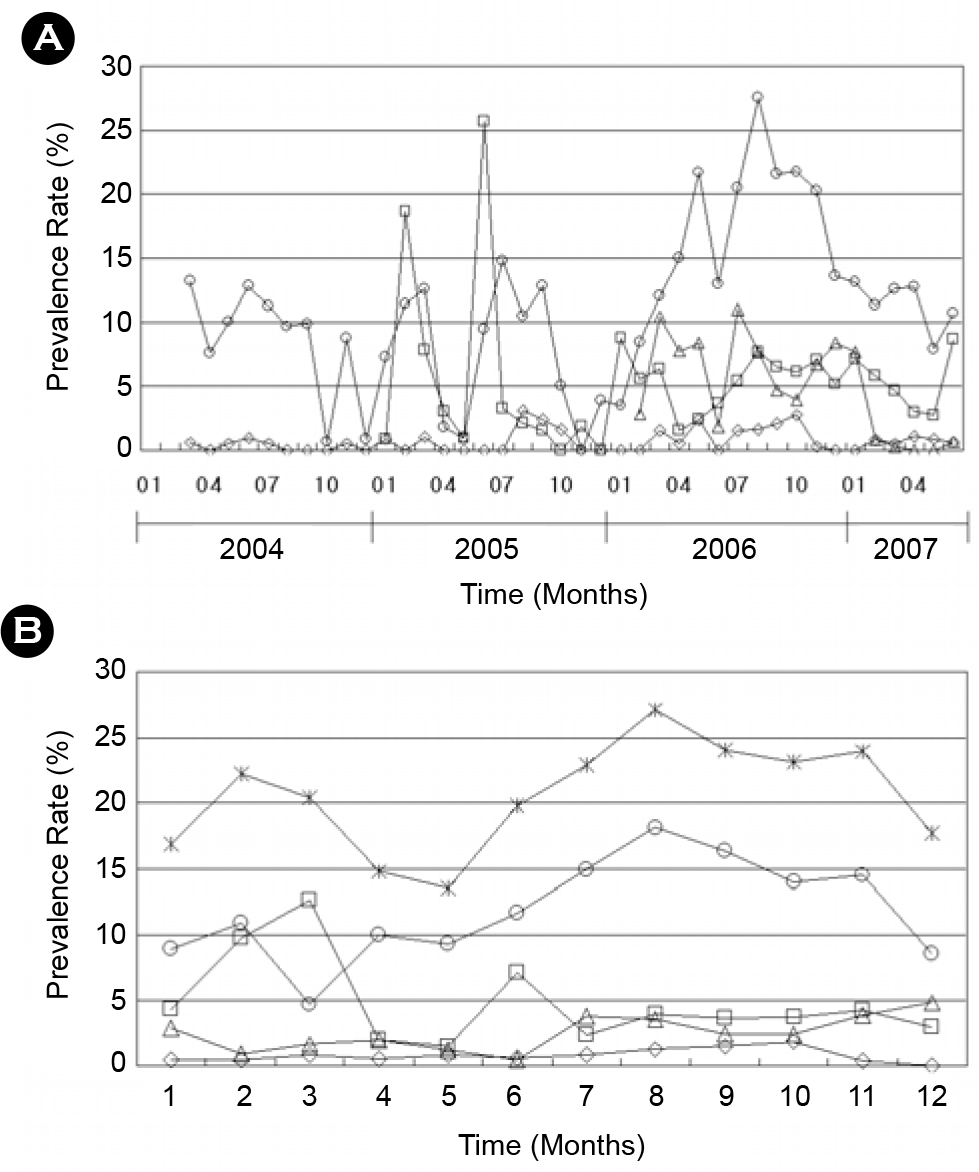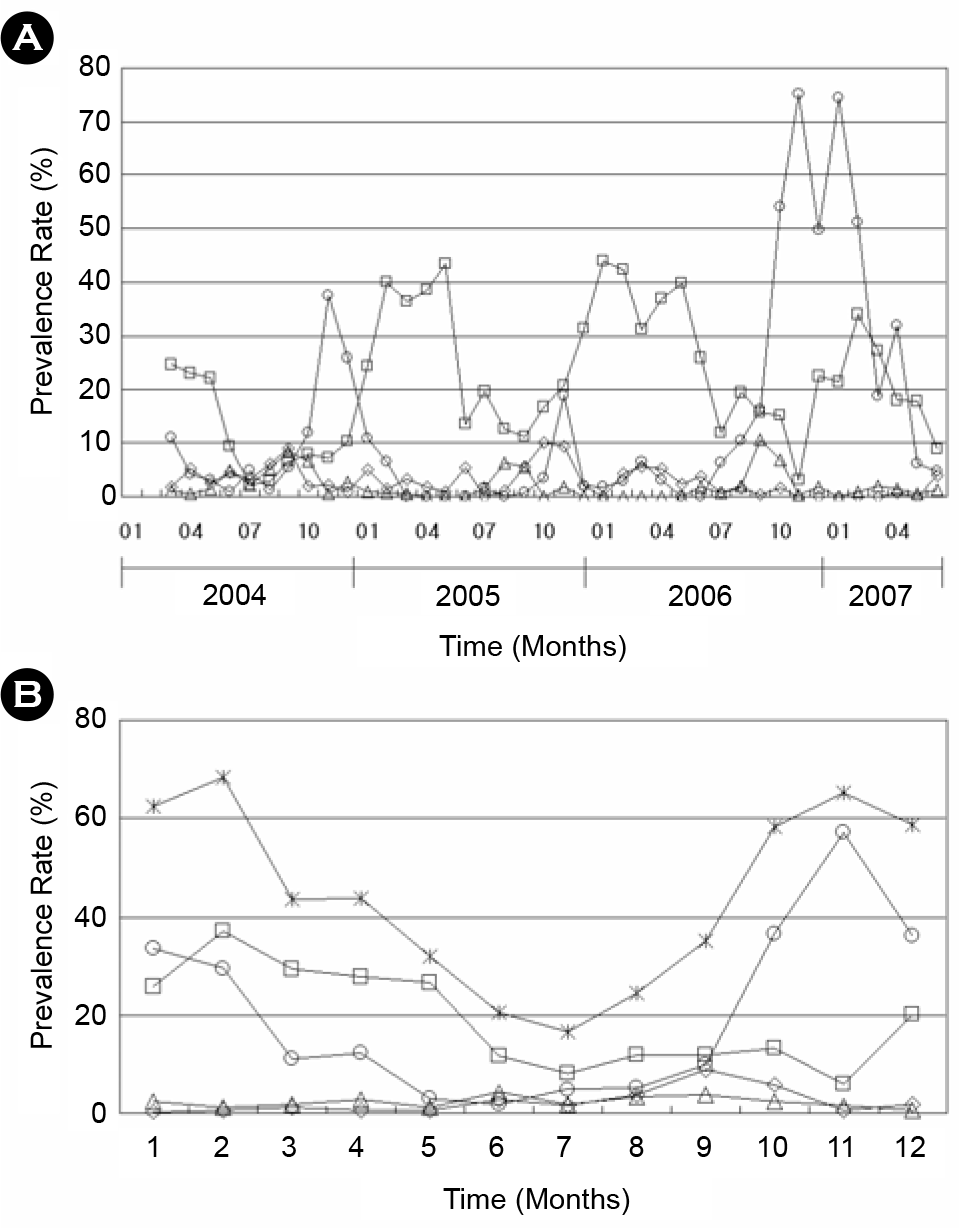Abstract
Acute gastroenteritis (AGE), which is one of the most common diseases worldwide, primarily occurs in infants and young children in both developed and developing countries. To investigate the prevalence of AGE in Korea, 6,788 stool specimens collected from hospitalized patients with AGE in Seoul, Korea from March 2004 to June 2007 were analyzed by enzyme immunoassay, reverse transcription-PCR, DNA sequencing and phylogenetic analysis. Enteric viruses and bacteria were detected in 2,955 (43.5%) and 1,389 (20.5%) specimens, respectively. Among the enteric viruses detected, rotavirus (19.7%) and norovirus (18.9%) were the predominant causative agents, followed by adenovirus (2.5%) and astrovirus (2.4%). Staphylococcus aureus was the most commonly observed bacteria (8.0~19.2%). The epidemic peaks of the enteric viruses were October to December for norovirus, January to May for rotavirus, and August to October for adenovirus. The seasonal activity of rotavirus was shifted from winter to late spring. However, astrovirus did not display seasonal activity in this study. Although viral AGE primarily occurred in patients younger than 5 years of age, the incidence of viral AGE in children aged 6 to 14 years was significant. The results of this study will contribute to the currently available epidemiological data and improve public health and hygiene via amelioration of diagnostic methods and longitudinal surveillance.
Go to : 
REFERENCES
1). Bryce J., Boschi-Pinto C., Shibuya K., Black RE. WHO Child Health Epidemiology Reference Group. WHO estimates of the causes of death in children. Lancet. 2005. 365:1147–52.
2). Victora CG., Bryce J., Fontaine O., Monasch R. Reducing deaths from diarrhoea through oral rehydration therapy. Bull World Health Organ. 2000. 78:1246–55.
3). Tucker AW., Haddix AC., Bresee JS., Holman RC., Parashar UD., Glass RI. Cost-effectiveness analysis of a rotavirus immunization program for the United States. JAMA. 1998. 279:1371–6.

4). Green KY. Caliciviridae: The Noroviruses. Fields Virology. 5th ed.Philadelphia: Lippincott Williams & Wilkins;2007. p. 949–80.
5). Fankhauser RL., Monroe SS., Noel JS., Humphrey CD., Bresee JS., Parashar UD., Ando T., Glass RI. Epidemiologic and molecular trends of “Norwalk-like viruses” associated with outbreaks of gastroenteritis in the United States. J Infect Dis. 2002. 186:1–7.

6). Lopman BA., Reacher MH., Van Duijnhoven Y., Hanon FX., Brown D., Koopmans M. Viral gastroenteritis outbreaks in Europe, 1995-2000. Emerg Infect Dis. 2003. 9:90–6.

7). Lynch M., Painter J., Woodruff R., Braden C. Centers for Disease Control and Prevention. Surveillance for foodborne-disease outbreaks-United States, 1998-2002. MMWR Surveill Summ. 2006. 55:1–42.
8). Svraka S., Duizer E., Vennema H., de Bruin E., van der Veer B., Dorresteijn B., Koopmans M. Etiological role of viruses in outbreaks of acute gastroenteritis in the Netherlands from 1994 through 2005. J Clin Microbiol. 2007. 45:1389–94.

9). Le Guyader FS., Bon F., DeMedici D., Parnaudeau S., Bertone A., Crudeli S., Doyle A., Zidane M., Suffredini E., Kohli E., Maddalo F., Monini M., Gallay A., Pommepuy M., Pothier P., Ruggeri FM. Detection of multiple noroviruses associated with an international gastroenteritis outbreak linked to oyster consumption. J Clin Microbiol. 2006. 44:3878–82.

10). Webby RJ., Carville KS., Kirk MD., Greening G., Ratcliff RM., Crerar SK., Dempsey K., Sarna M., Stafford R., Patel M., Hall G. Internationally distributed frozen oyster meat causing multiple outbreaks of norovirus infection in Australia. Clin Infect Dis. 2007. 44:1026–31.

11). Simmons G., Garbutt C., Hewitt J., Greening G. A New Zealand outbreak of norovirus gastroenteritis linked to the consumption of imported raw Korean oysters. N Z Med J. 2007. 120:U2773.
12). Hjertqvist M., Johansson A., Svensson N., Abom PE., Magnusson C., Olsson M., Hedlund KO., Andersson Y. Four outbreaks of norovirus gastroenteritis after consuming raspberries, Sweden, June-August 2006. Euro Surveill. 2006. 11:E060907. .1.

13). Falkenhorst G., Krusell L., Lisby M., Madsen SB., Böttiger B., M⊘lbak K. Imported frozen raspberries cause a series of norovirus outbreaks in Denmark, 2005. Euro Surveill. 2005. 10:E050922. .2.

14). Cotterelle B., Drougard C., Rolland J., Becamel M., Boudon M., Pinede S., Traoré O., Balay K., Pothier P., Espié E. Outbreak of norovirus infection associated with the consumption of frozen raspberries, France, March 2005. Euro Surveill. 2005. 10:E050428. .1.

15). Schenkel K., Williams C., Eckmanns T., Poggensee G., Benzler J., Josephsen J., Krause G. Enhanced surveillance of infectious diseases: the 2006 FIFA World Cup experience, Germany. Euro Surveill. 2006. 11:234–8.
16). Cho SH., Kim JH., Kim JC., Shin HH., Kang YH., Lee BK. Surveillance of bacterial pathogens associated with acute diarrheal disease in the Republic of Korea during one year, 2003. J Microbiol. 2006. 44:327–35.
17). Noel JS., Lee TW., Kurtz JB., Glass RI., Monroe SS. Typing of human astroviruses from clinical isolates by enzyme immunoassay and nucleotide sequencing. J Clin Microbiol. 1995. 33:797–801.

18). Kim EJ., Park SH., Song MO., Kim MS., Kim MY., Cheon DS., Jeong HS., Kim CJ. Genetic distribution of human noroviruses detected from acute gastroenteritis patients in Seoul. Kor J Microbiol. 2008. 44:135–9.
19). Lee JI., Song MO., Chung JY., Han TH., Ahn YM., Seo JW., Kim MS., Kim MY., Kim WY., Lee CH. Outbreak of rotavirus variant P[8] in Seoul, South Korea. J Med Virol. 2008. 80:1661–5.

20). Huh JW., Kim WH., Moon SG., Lee JB., Lim YH. Viral etiology and incidence associated with acute gastroenteritis in a 5-year survey in Gyeonggi province, South Korea. J Clin Virol. 2009. 44:152–6.

21). Brandt CD., Kim HW., Rodriguez WJ., Arrobio JO., Jeffries BC., Parrott RH. Rotavirus gastroenteritis and weather. J Clin Microbiol. 1982. 16:478–82.

23). Sánchez-Fauquier A., Wilhelmi I., Colomina J., Cubero E., Roman E. Diversity of group A human rotavirus types circulating over a 4-year period in Madrid, Spain. J Clin Microbiol. 2004. 42:1609–13.

24). Suzuki H., Sakai T., Tanabe N., Okabe N. Peak rotavirus activity shifted from winter to early spring in Japan. Pediatr Infect Dis J. 2005. 24:257–60.

25). Cruz JR., Bartlett AV., Herrmann JE., Cáceres P., Blacklow NR., Cano F. Astrovirus-associated diarrhea among Guatemalan ambulatory rural children. J Clin Microbiol. 1992. 30:1140–4.

26). Mendez E., Arias CF. Astroviruses. Fields Virology. 5th ed.Philadelphia: Lippincott Williams & Wilkins;2007. p. 981–1000.
27). Giordano MO., Martinez LC., Isa MB., Paez Rearte M., Nates SV. Childhood astrovirus-associated diarrhea in the ambulatory setting in a Public Hospital in Cordoba City, Argentina. Rev Inst Med Trop Sao Paulo. 2004. 46:93–6.

28). Shimizu H., Phan TG., Nishimura S., Okitsu S., Maneekarn N., Ushijima H. An outbreak of adenovirus serotype 41 infection in infants and children with acute gastroenteritis in Maizuru City, Japan. Infect Genet Evol. 2007. 7:279–84.

29). Kosek M., Bern C., Guerrant RL. The global burden of diarrhoeal disease, as estimated from studies published between 1992 and 2000. Bull World Health Organ. 2003. 81:197–204.
30). Dennehy PH., Nelson SM., Spangenberger S., Noel JS., Monroe SS., Glass RI. A prospective case-control study of the role of astrovirus in acute diarrhea among hospitalized young children. J Infect Dis. 2001. 184:10–5.

31). Guerrero ML., Noel JS., Mitchell DK., Calva JJ., Morrow AL., Martínez J., Rosales G., Velázquez FR., Monroe SS., Glass RI., Pickering LK., Ruiz-Palacios GM. A prospective study of astrovirus diarrhea of infancy in Mexico City. Pediatr Infect Dis J. 1998. 17:723–7.

32). Herrmann JE., Taylor DN., Echeverria P., Blacklow NR. Astro-viruses as a cause of gastroenteritis in children. N Engl J Med. 1991. 324:1757–60.

33). Rodriguez-Baez N., O'Brien R., Qiu SQ., Bass DM. Astrovirus, adenovirus, and rotavirus in hospitalized children: prevalence and association with gastroenteritis. J Pediatr Gastroenterol Nutr. 2002. 35:64–8.

34). Rohayem J., Berger S., Juretzek T., Herchenroder O., Mogel M., Poppe M., Henker J., Rethwilm A. A simple and rapid single-step multiplex RT-PCR to detect norovirus, astrovirus and adenovirus in clinical stool samples. J Virol Methods. 2004. 118:49–59.
35). Walter JE., Mitchell DK., Guerrero ML., Berke T., Matson DO., Monroe SS., Pickering LK., Ruiz-Palacios G. Molecular epidemiology of human astrovirus diarrhea among children from a periurban community of Mexico City. J Infect Dis. 2001. 183:681–6.

36). Gabbay YB., Leite JP., Oliveira DS., Nakamura LS., Nunes MR., Mascarenhas JD., Heinemann MB., Linhares AC. Molecular epidemiology of astrovirus type 1 in Belem, Brazil, as an agent of infantile gastroenteritis, over a period of 18 years (1982~2000): Identification of two possible new lineages. Virus Res. 2007. 129:166–74.
Go to : 
 | Figure 1.Prevalence of bacterial gastroenteritis in Seoul, Korea, 2004~2007. A) Yearly prevalence of bacterial gastroenteritis. B) Monthly average prevalence of bacterial agents isolated from acute gastroenteritis patients.
(∗), Total bacteria detected; (○), Staphylococcus aureus; (□), Escherichia coli; (Δ), Clostridium perfringens; (◇), Salmonella spp.
|
 | Figure 2.Prevalence of viral gastroenteritis in Seoul, Korea, 2004~2007. A) Yearly prevalence of bacterial gastroenteritis. B) Monthly average distribution of viral agents isolated from acute gastroenteritis patients.
(∗), Total viruses detected; (○), Norovirus; (□), Rotavirus; (◇), Adenovirus; (Δ) Astrovirus
|
Table 1.
Etiologic agents of gastroenteritis in Seoul, Korea, 2004~2007
| Etiologic agents | Number of samples (%) | ||||
|---|---|---|---|---|---|
| 2004 (n=1,836) | 2005 (n=1,338) | 2006 (n=2,213) | 2007 (n=1,401) | To tal (n=6,788) | |
| S. aureus | 166 (9.0) | 107 (8.0) | 424 (19.2) | 162 (11.6) | 859 (12.7) |
| E. coli | 0 (0.0) | 75 (5.6) | 130 (5.9) | 70 (5.0) | 275 (4.1) |
| Salmonella spp. | 6 (0.3) | 11 (0.8) | 29 (1.3) | 10 (0.7) | 56 (0.8) |
| C. perfringens | 0 (0.0) | 0 (0.0) | 144 (6.5) | 17 (1.2) | 161 (2.4) |
| Othersa | 0 (0.0) | 4 (0.3) | 21 (0.9) | 13 (0.9) | 38 (0.6) |
| Sum of Bacteria | 172 (9.4) | 197 (14.7) | 748 (33.8) | 272 (19.4) | 1,389 (20.5) |
| Norovirus | 176 (9.6) | 48 (3.6) | 638 (28.8) | 420 (30.0) | 1,282 (18.9) |
| Rotavirus | 206 (11.2) | 372 (27.8) | 445 (20.1) | 316 (22.6) | 1,339 (19.7) |
| Adenovirus | 64 (3.5) | 19 (1.4) | 71 (3.2) | 16 (1.1) | 170 (2.5) |
| Astrovirus | 73 (4.0) | 47 (3.5) | 36 (1.6) | 8 (0.6) | 164 (2.4) |
| Sum of Viruses | 519 (28.3) | 486 (36.3) | 1,190 (53.8) | 760 (54.2) | 2,955 (43.5) |
Table 2.
Detection of known etiologic agents of gastroenteritis in different age groups in Seoul, Korea, 2004~2007




 PDF
PDF ePub
ePub Citation
Citation Print
Print


 XML Download
XML Download